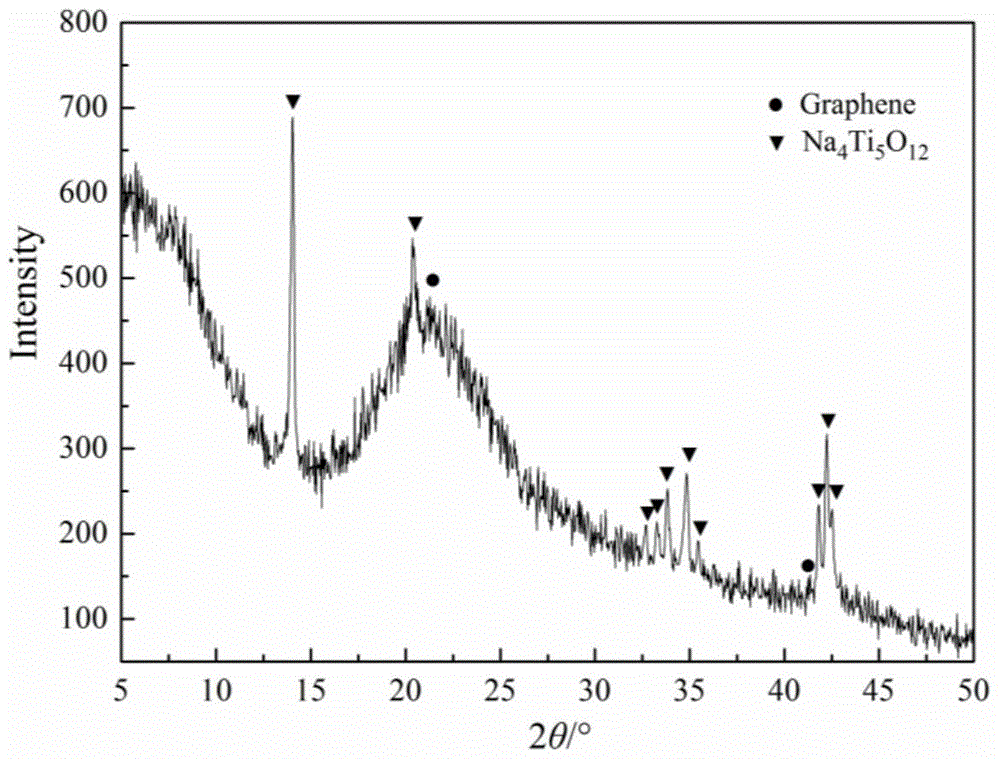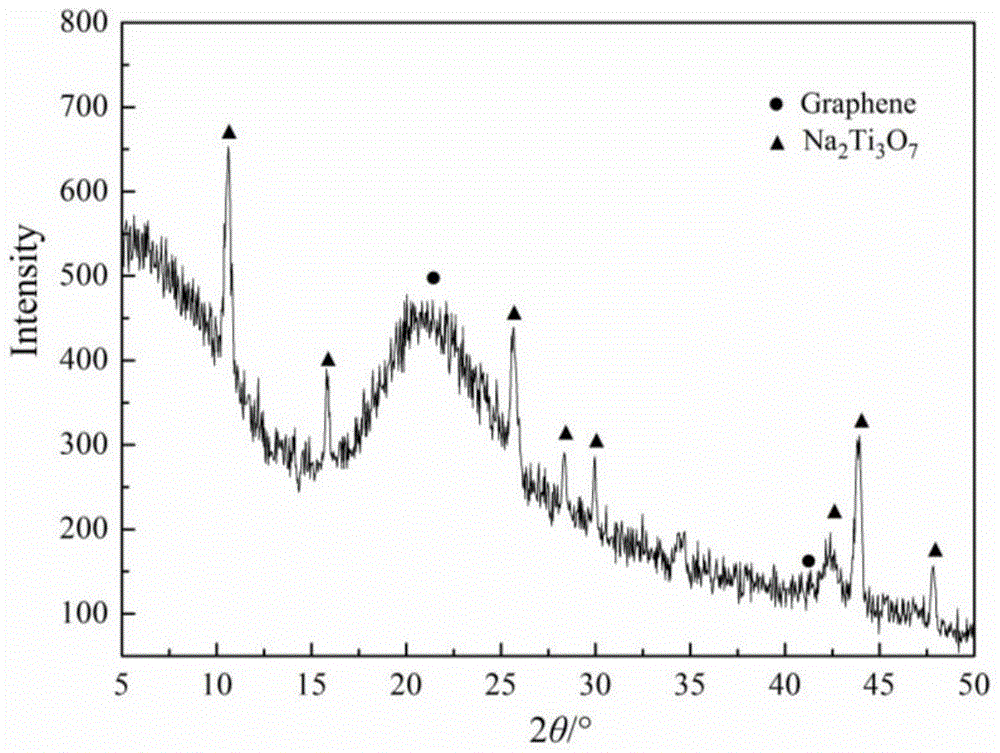A kind of preparation method of sodium titanate/graphene composite negative electrode material for sodium ion battery
A graphene composite and sodium-ion battery technology, which is applied in battery electrodes, secondary batteries, circuits, etc., can solve the problem of poor electronic and ionic conductivity of sodium titanate, poor high-current discharge performance, and capacity must be fully utilized, etc. problems, to overcome the poor ionic conductivity, improve electronic conductivity, and facilitate storage and diffusion
- Summary
- Abstract
- Description
- Claims
- Application Information
AI Technical Summary
Problems solved by technology
Method used
Image
Examples
preparation example Construction
[0030] The preparation method of graphite oxide is as follows:
[0031] Take an appropriate amount of concentrated H with a mass fraction of 95-98% 2 SO 4 Add to the reaction vessel placed in the ice bath, start stirring, and add graphite and KMnO at 20-100rpm 4 React for 30-60 minutes; then raise the temperature of the reaction solution to 40±2°C, react for 30-60 minutes; then control the temperature of the reaction solution at 95-100°C, add deionized water to the solution for 30-60 minutes; then add an appropriate amount H with a mass fraction of 5% 2 o 2 Finally, the reaction solution was filtered, and the filter residue was washed with 5% HCl until there was no SO in the filtrate. 4 2- (with BaC1 2 solution detection); then use deionized water to wash the filter residue to neutrality, and vacuum filter to obtain paste-like graphite oxide;
[0032] Among them, graphite is natural flake graphite or artificial graphite, with a particle size of 0.04-30 μm; concentrated ...
Embodiment 1
[0034] 1. Take 10g of graphite oxide and add it to 50mL of absolute ethanol, then add 0.1g of γ-aminopropyltriethoxysilane, and conduct ultrasonic treatment at a constant temperature of 60°C for 30min to obtain a graphene oxide solution;
[0035] 2. Add 8g of tetraethyl titanate to 400mL of absolute ethanol, stir at 20-50rpm, add formic acid to adjust the pH of the solution to 5, then add the graphene oxide solution obtained in step 1, and mix evenly to obtain titanium-containing Graphene oxide solution; then take the sodium acetate aqueous solution containing 0.028mol sodium acetate, add the sodium acetate aqueous solution dropwise to the titanium-containing graphene oxide solution at a rate of 0.5mL / min, and stir the reaction at 20-50rpm 20min, and after standing still for 2h, wash with deionized water for 3 to 5 times, vacuum filter, and dry to obtain the composite precursor;
[0036] 3. Mix 10g of the composite precursor prepared in step 2 with 5mL of deionized water and 0...
Embodiment 2
[0041] 1. Take 10g of graphite oxide and add it to 200mL of absolute ethanol, then add 0.5g of γ-(2,3-glycidoxy)propyltrimethoxysilane, and conduct ultrasonic treatment at a constant temperature of 30°C for 240min to obtain graphene oxide solution;
[0042] 2. Add 32g of tetrabutyl titanate to 320mL of absolute ethanol, stir at 20-50rpm, add HCl to adjust the pH of the solution to 2, then add the graphene oxide solution obtained in step 1, and mix evenly to obtain titanium-containing Graphene oxide solution; Then get the sodium oxalate aqueous solution that contains 0.031mol sodium oxalate, with the drop rate of 3mL / min, the sodium oxalate aqueous solution is added dropwise in the graphene oxide solution containing titanium, at 20~ Stir and react at 50rpm for 60min, then let stand for 6h, wash with deionized water for 3 to 5 times, vacuum filter and dry to obtain a composite precursor;
[0043] 3. Take 10g of the composite precursor prepared in step 2, mix it with 15mL of dei...
PUM
| Property | Measurement | Unit |
|---|---|---|
| diameter | aaaaa | aaaaa |
| particle size | aaaaa | aaaaa |
| diameter | aaaaa | aaaaa |
Abstract
Description
Claims
Application Information
 Login to View More
Login to View More - R&D
- Intellectual Property
- Life Sciences
- Materials
- Tech Scout
- Unparalleled Data Quality
- Higher Quality Content
- 60% Fewer Hallucinations
Browse by: Latest US Patents, China's latest patents, Technical Efficacy Thesaurus, Application Domain, Technology Topic, Popular Technical Reports.
© 2025 PatSnap. All rights reserved.Legal|Privacy policy|Modern Slavery Act Transparency Statement|Sitemap|About US| Contact US: help@patsnap.com


